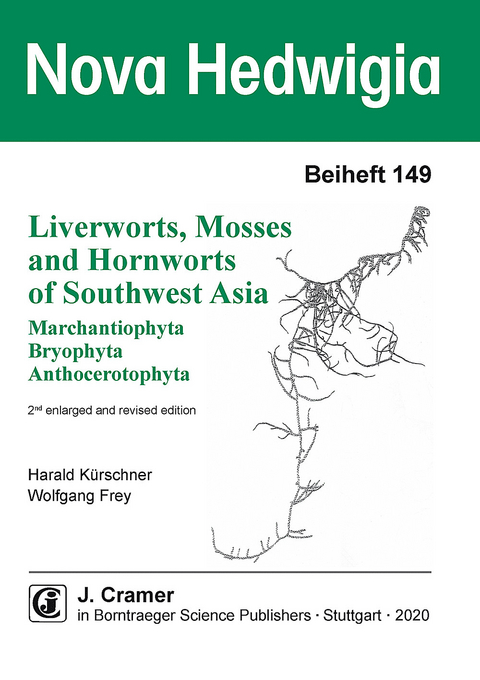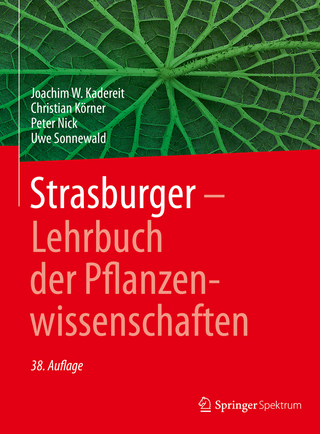
Liverworts, Mosses and Hornworts of Southwest Asia (Marchantiophyta, Bryophyta, Anthocerotophyta)
A systematic treatise with keys to genera and species occuring in Afghanistan, Bahrain, Iraq, Iran, Israel, Jordan, Kuwait, Lebanon, Oman, Qatar, Saudi Arabia, Sinai Peninsula, Syria, Turkey, United Arab Emirates and Yemen (inc. Socotra Island)
Seiten
2020
|
2. enlarged and revised edition
Borntraeger (Verlag)
978-3-443-51071-8 (ISBN)
Borntraeger (Verlag)
978-3-443-51071-8 (ISBN)
The new, enlarged and revised flora replaces the former flora "The Liverworts, Mosses and Hornworts of Southwest Asia (Marchantiophyta, Bryophyta, Anthocerotophyta)" (2011) which was the first comprehensive bryophyte flora and wellstructured synthesis of the current knowledge available on the liverworts, mosses and hornworts of Southwest Asia (Near and Middle East). As the former flora, this enlarged and revised new edition covers Afghanistan, Bahrain, Iraq, Iran, Israel, Jordan, Kuwait, Lebanon, Oman, Qatar, Saudi Arabia, Sinai Peninsula, Syria, Turkey, United Arab Emirates, and Yemen (incl. the Socotra Archipelago), summarized to a great extend as "Asia 5" in the "Index Muscorum". Since the first publication in 2011, scientific interest in bryophytes drastically increases, resulting in more than 70 additional species, formerly unknown to the area and the first moss records to Qatar Peninsula. In total, nearly 1400 taxa (255 liverworts, 1128 mosses, 5 hornworts) and nearly 2300 names and synonyms were treated. The dichotomous keys provide families, genera and species, including annotations to distribution and to critical, doubtful or erroneously recorded species.
The flora includes all bryophyte taxa known to date within this large and varied climatological and geomorphological area. It responds to the tools of the Conservation on Biological Diversity and the Target 1 of the updated Global Strategy for Plant Conservation. Main goal beside identification is to achieve a checklist of all known plants of this often neglected and/or overlooked group of organisms. It is a further step to integrate Southwest Asia (Near and Middle East) into the Global Network of floristic knowledge.
As many of the species are important initial colonizers of bare rocks, crusts and soil surfaces in steppe and desert regions of the area and are forerunners in vascular plant colonization and succession, their knowledge is of fundamental importance for understanding phytodiversity and ecosystems and provides access to taxonomic information, important for nature conservation. It enables us to give a more precise answer to the question how many plant species occur in the area and it is a step to enhanced education and scientific understanding on the wealth of plant diversity.
The book is recommended to all botanists and ecologists, interested in bryophyte flora and vegetation, biodiversity and nature conservation and may stimulate and promote greater interest in bryophytes. We hope, it is also in future a mandatory reference for students, experts and researchers.
The flora includes all bryophyte taxa known to date within this large and varied climatological and geomorphological area. It responds to the tools of the Conservation on Biological Diversity and the Target 1 of the updated Global Strategy for Plant Conservation. Main goal beside identification is to achieve a checklist of all known plants of this often neglected and/or overlooked group of organisms. It is a further step to integrate Southwest Asia (Near and Middle East) into the Global Network of floristic knowledge.
As many of the species are important initial colonizers of bare rocks, crusts and soil surfaces in steppe and desert regions of the area and are forerunners in vascular plant colonization and succession, their knowledge is of fundamental importance for understanding phytodiversity and ecosystems and provides access to taxonomic information, important for nature conservation. It enables us to give a more precise answer to the question how many plant species occur in the area and it is a step to enhanced education and scientific understanding on the wealth of plant diversity.
The book is recommended to all botanists and ecologists, interested in bryophyte flora and vegetation, biodiversity and nature conservation and may stimulate and promote greater interest in bryophytes. We hope, it is also in future a mandatory reference for students, experts and researchers.
| Erscheinungsdatum | 01.02.2020 |
|---|---|
| Reihe/Serie | Nova Hedwigia ; 149 |
| Verlagsort | Stuttgart |
| Sprache | englisch |
| Maße | 170 x 240 mm |
| Gewicht | 570 g |
| Themenwelt | Naturwissenschaften ► Biologie ► Botanik |
| Schlagworte | Bryology • bryophyte flora • Plant diversity • Taxonomy • Vegetation |
| ISBN-10 | 3-443-51071-X / 344351071X |
| ISBN-13 | 978-3-443-51071-8 / 9783443510718 |
| Zustand | Neuware |
| Informationen gemäß Produktsicherheitsverordnung (GPSR) | |
| Haben Sie eine Frage zum Produkt? |
Mehr entdecken
aus dem Bereich
aus dem Bereich
Diversität, Morphologie, Ökologie und Evolution der Pilze
Buch | Softcover (2023)
Springer (Verlag)
49,99 €
Gefäßpflanzen: Grundband
Buch | Hardcover (2021)
Springer Spektrum (Verlag)
44,99 €


